SAAB Flyer # 5
September, 2002 Download Saab Flyer # 5 Word File (203KB)
Feature Article was published in NINES - official Newsletter of the Saab Club of North America. Issue #261 Jan/Feb 2003. www.saabclub.comIn the past we have picked on quicki-type oil servicing, and tire-muffler-generic stores, and otherwise incompetent service for your Saab. With this issue we explore government regulation, public perceptions and marketing strategies affecting your pocketbook & safety.
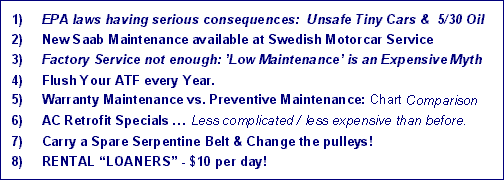
![]()
Manufacturer’s Fleet Fuel Reduction Regs are stimulating technology, but leading toward increased traffic fatalities and higher repair bills.
Governmental policies, aimed at reducing our reliance on imported crude oil while placating political opposition to domestic drilling, are requiring manufacturers to produce vehicles with ever-increasing fuel economy. These policies have stimulated technology for improvements, but also resulted in smaller, lighter, less safe cars, often the root cause of traffic fatalities.
Also, lighter 0-30 and 5-30 engine oils have been adopted to improve mileage but can severely shorten engine life. Up to now, the public has not connected these dots and made the conclusion that some of these measures are counterproductive. The story is as complicated as it is convoluted, but this is how I see it evolving.
Automobile manufacturers are required to comply with CAFE (Corporate Average Fuel Economy) standards to sell vehicles in the US. Currently, this number is 27.5 mpg for passenger cars. This means that all vehicles sold in that manufacturer’s passenger "Fleet", all lumped together, must average 27.5 mpg.
Because of the way that the law is currently written, to sell the larger, more powerful, luxury and profitable models in the fleet, a smaller, fuel-economical model must be sold to offset the fuel mileage average so that stiff penalties ($55 for each mpg, per vehicle! ) can be avoided. Fuel mileage "credits" can also be accumulated to comply with past or future Café standards.
So if a high percentage of tiny passenger cars are sold, larger, more profitable models can also be sold without violating the standard. This partly explains the current trends toward the ultra-small, ultra cheap models which are marketed without mention of their poor safety records, and why the Big Three, (GM, Ford, Chrysler) have bought Import companies, such as Saab, Volvo and Mercedes.
Not unlike the Japanese strategy of Mandated Obsolescence, (see "Low Maintenance Myth") some corporate strategies to comply with CAFÉ standards will cost consumers billions. Ecology-wise, they will not be as beneficial as hoped and may actually be counter-productive in some ways.
For example: fewer oil and fluid changes and lighter oils for increased fuel mileage are being touted as the means to save energy and lower the "waste by-products" of automobiles. But these measures will inevitably result in engines, transmissions and other components worn out sooner than normal, requiring expensive repairs and premature replacement of the family car. This will certainly result in more "waste by-products" in reclaiming the old vehicles, and require considerable energy and resources to build the replacement cars, not to mention the additional drain on the family budget, adding to billions, nationwide.
The cost of this kind of wastefulness is not computed, or even spoken of today, because it will be conducive to more manufacturing and sales of yet more lightweight vehicles. This has already led to a self-perpetuating, profitable obsolescence in the auto repair industry, and a flourishing tiny car market.
So while new manufacturing is updating our automobile technology, and this is good for our economy, and there’s no question that newer cars are cleaner burning than older models, the consumer is being sold a Trojan Horse in the form of environmental protection. In reality, it is the dawn of a new era in automobile marketing disguised as environmental correctness. It is aimed at the consumer’s pocketbook, with insufficient regard for consumer safety.
How does this affect the Saab owner?
Saab continues to lead the industry with safety technology such as Saab Active Head Restraint’, Intelligent Air Bag and Large Animal Collision technologies, and leading edge engine design and engine management systems, despite their use of conventional European platforms upon which to build their vehicles. ( the new style 900 was an Opel platform; the 9-3 is a Euro GM platform) .
Aside from losing the Heavy Beam door reinforcement of the past 900’s, and the use of lighter guage and softer metals used in platform and fender construction, (as it appears to me; the 96’s and 99’s were almost drill-bit-proof ) the modern Saab is undoubtedly safer than ever before. At least for the time being, more significant to today’s Saab owner are the consequences to longevity.
In the past, the 250,000 mile Saab, if cared for, was a realistic expectation. Maintenance books, while still lacking in some items, stressed the importance of good preventive maintenance. Specialists in maintenance (like us) supplemented the book with items such as thermostat replacements, additional transmission servicings etc. all with the goal of keeping the Saab for a very long time.
Today, however, low maintenance costs are emphasized, almost as if the need for servicing was something the manufacturer was ashamed of.
I see inadequate maintenance, compounded by high parts and labor costs resulting in less older Saabs in the future available to families who cannot afford new ones; certainly less commonplace than generic, domestic and Japanese counterparts. At least there are hundreds of thousands of Toyota’s and other look-alike mid-size luxury models on the roads, providing an inexpensive source of used parts through the wrecking yards. With Saab however, the small numbers will always keep the prices at a premium, ultimately resulting in less of them being refurbished and kept for the higher mileages they once enjoyed.
More immediate than inadequate maintenance recommendations, however, is the recent use of extremely lightweight engine oils, such as Saab’s 5-30 semi-synthetic, which is incorrectly thought to be required in new Saabs. Up to 2000 model year, 5-30 was only recommended in climates where the temperature was consistently 4 degrees below zero!
Many dealers are using this oil in all models regardless of age. I’ve heard that Saab claims the 5-30 will help to "cool the turbocharger", and more quickly lubricate the bearings on startup. In my opinion, the primary reason is to help comply with CAFÉ standards, and the use of this lighter oil will require engine repairs or replacement 70,000 - 100,000 miles sooner than if heavier oils were employed. Saab engines of the past usually lasted the life of the car.
It is interesting that GM Import ( the European Corp. that now owns Saab), and several other manufacturers were projected to fail CAFÉ standards in 2000 and expected to pay stiff civil penalties for these infractions. This was the same year that the 5/30 oil was introduced. In fact, the owner’s manual for a ’99 9-5 with "Ecopower" 2.3L specifically states in their oil specifications, that in climates where " temperatures of 60 deg. F or above, use 15/50 or 20/50")
I talked to Steve Goldberger of NINE’s Magazine, the official newsletter of the Saab Club of America, about this problem. He was skeptical of my theories because at this time GM Imports only sells Saab and Suzuki in the USA. Both models are reasonably fuel-efficient. But 27.5 mpg is pushing the limits of any automatic transmission model, and the accumulated "credits" to offset shortfalls in other years is yet another possibility. Higher horsepower figures are also achieved with lighter oils; another incentive though engine longevity is sacrificed.
How do lighter oils shorten engine life? My 40 years of experience with engines has shown that the engine bearings, (Connecting Rod, and Crankshaft Main Bearings) will bear the brunt of the damage. Engines older than 60K miles old will also wear out camchains, pistons, and valve guides if 7000 -10,000 mile oil changes are adopted to "reduce waste byproducts" of automobiles.
As to engine bearings, even the 10 wt. Multi-grades, (10-30; 10-40 & even 10-50’s), synthetic and non-synthetic, do not cushion the engine bearings sufficiently after 60K. There are wide parameters in the way oils are rated for viscosity and as a Saab Specialist- I have known for 30 years that the 10-weights were not viscous (thick) enough at operating temps. Any farmer knows that straight 30 wt. oil is much heavier than any 10-30, 10-40 and sometimes 10-50’s depending on the operating temperature of the oil.
In California, we used 20-40 oils, and in the northwest- Mobil 1 (15/50) works best. In winter- we mix 10-30 and 15/50 for the proper viscosity.
The problem is that after initial wear- the engine settles into approx. .002" -.0025" bearing clearance after 60,000 miles, usually. At this clearance, the effects of the lubricative oil "wedge" formed between the engine bearing and crankshaft are greatly diminished, and a 10wt. multi-grade oil will not cushion the shock loads of the bearings adequately. The bearings will be "hammered" until losing their proper fit in the connecting rods or engine block. The resulting vibrations, especially with hard hitting knock sensor engines, will continue to flatten these bearings until they may eventually fail or "spin" in their confinement, closing off the oil passage which passes through them, destroying the engine immediately.
This condition puts the engine in an unreliable condition, because no one can predict when a bearing might spin. So even if the engine does not fail, the rattling and vibrations make it sound and feel "worn out", and it is rendered useless as the primary reliable family vehicle. Some experts say lightweight oils will reach the bearings sooner on startup, and that this is where most wear occurs, but in my experience, far more damage occurs from hammered bearings due resulting from lightweight oils.
In our racing experience, we regularly fit bearings to these "loose" clearances for more power (less friction, which would also give more fuel mileage). But this was for a racing engine which had to be overhauled every season to maintain reliability. This is a procedure no Saab owner should ever have to be faced with, especially when Saab’s 4 cylinder motors are capable of running 300,000 miles and still be smooth and tight, if given the proper viscosity oil, and changed every 3K for Mineral, or 5K for Synthetics.
The 5-weight oil strategy is only a stop-gap measure for conventional engine construction. In the future, Ceramic, low friction bearings are on the horizon, and low friction technologies will eventually make some true progress toward fuel efficiency. Right now, the adoption of light-weight oils is comparable to the 70’s technology adopted by domestic and Japanese manufacturers when they glossed over their extremely polluting engines with what became known as "smog devices". The Europeans, led by Saab and others, employed efficient fuel injection and other technologies, which have survived to this day and are now employed by virtually all manufacturers.
We urge you to combine your Common Sense regarding preventive maintenance, and Saab’s great technologies, to protect your investment!
Saab’s specs on oils require an ACEA European specification of "A3/B3" (more info in a newer Saab owner’s manual). Mobil 1 makes 2 synthetic oils which are tested & approved: their "0-40" and their "15/50". The 10-30 would certainly comply with the standards, according to the Mobil engineer I spoke with, but this weight has not been submitted for testing. Also, this engineer recommended 15/50 all year long, even in cold climates, as the oil will pour at temperatures -35 deg. F. below zero. We have found that mixing with 10-30 is a better alternative, however.
Worse than considerations of fuel economy are those of Safety.
CAFE laws are resulting in smaller, lighter, and much more UNSAFE automobiles on our streets.
Despite modern SRS technologies, people are dying in tiny compact and subcompact cars, and the consumer is also paying increased insurance costs not only from injuries, but also from astronomical body repair costs as a result of modern (cheap) construction.
Examples: where did the true 5 mph bumper go? - it disappeared under a painted plastic panel, which weighed less, but offers little damage protection.
Some modern cars sustain thousands of dollars in damage from a simple 5 mph impact! The Curb Weight and the guage and temper of metals used in the construction have "Tons" to do with how this vehicle cushions and protects its occupants, especially comparing it to the weight and metal strength of the vehicle it is colliding with. This is the irrefutable physics of the matter. Some of these smaller, "economy" cars are a full 1000 lbs lighter than a Saab, and tons less than full sized vehicles.
Parents of new Teen Drivers, and the public, ‘ignorant-at-large’ of traffic and highway fatality statistics, are being misled into the many cute new models on the road. Instead of putting their new teen driver in a larger, heavier and more protective model, preparing for the inevitable learning curve most teens experience (resulting in an accident! ). These smaller models are being touted as being "state of the art safety technology" just because they have seat belts and air bags. This is not true!
There is a dangerous myth existing in our country, that because all vehicles pass the same government "safety tests" they are equally "safe". This is total Bunk!
Just to set the record straight, our NTSB tests are but a few simple collision and roof strength tests, and several imports and domestics still do no more than comply with our poor safety standards. In the 70-80’s the domestic and Japanese manufacturers knew better, but their cars were no safer than what was required here. Sweden and much of Europe had their own standards, however, and exported their safer technology to the US. Today, Saab claims to have over 40 separate crash tests before they will put their name on the line.
A small vehicle may pass some collision tests by being driven into a wall or the corner of an offset barrier with it’s own speed and mass. But this does not accurately reflect many other collisions, when vehicles of unequal weight collide into one another at different angles and speeds, especially if that other vehicle is larger, heavier, or taller with higher bumpers.
Some SUV’s and pickups with oversize tires have bumpers that are higher than the door glass on the smaller compact! This amounts to Zero Side Impact protection, but the government and insurance tests don’t even account for this disparity.
No matter what the collision matchup with a larger vehicle, the compact or subcompact is bound to absorb most of the damage; and its occupants, the most injuries and fatalities.
Some later models have been expanded in size, but still lack the weight and collision/rollover protection because of much lighter platform construction, no beams in the doors, inferior safety cages, and few of the safety features that have made Saab’s reputation premier, worldwide.
In the Northwest, we have a very unsafe mix of smaller, cheaper cars, and larger, heavier truck-type models. To insurance company statisticians, the risks are well known. But when was the last time you heard on a news commentary that "the occupants of the subcompact were killed because they collided with a vehicle 2-3 times their gross weight, or because they were run over by a vehicle twice in height"?
I see the CAFÉ laws, and political pressures surrounding oil drilling and environmentalism mixing with marketing strategies, to bring about basic changes in our personal transportation; some of them very detrimental.
Fortunately, the consumer still has choices. Safer, heavier, larger quality passenger cars like Saab are available to discriminating buyers. They are more expensive, but that expense can be offset by effective Preventive Maintenance using the proper lubricants to preserve your investment for many years. Tiny Car fatalities should not have to compensate for bad environmental law.
![]()
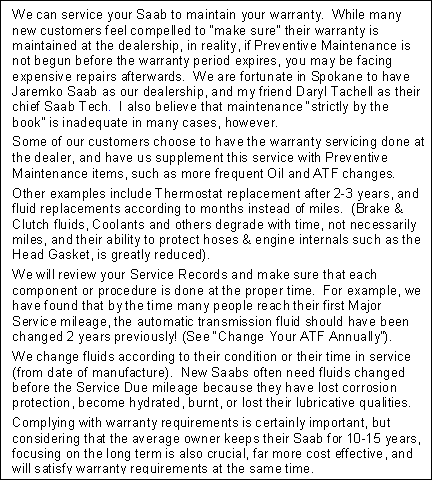
![]()
Preventive Maintenance has not essentially changed in 30 years, but manufacturer’s incomplete maintenance recommendations are leading toward ‘Disposable Cars’, including Saab…
There isn’t a day that goes by without Brad and I seeing the expensive consequences of poor preventive maintenance. In fact, nearly half of the repairs we do are an indirect result of poor maintenance or incompetent repairs done in the past. Most conscientious technicians echo the same observation, regardless of the type of vehicle they service. We’ve given examples of it for years in our newsletters, and seen the same sad stories play themselves over and over again throughout years. This is why we urge good Preventive Maintenance of your Saab.
Owners that allow us to properly care for their Saabs often keep the same model for up to 15 or more years, while the others never seem to catch on to the rhythm of Preventive Maintenance, or they entrust the wrong people to perform it. With the exception of some skilled Do-it-Yourselfer’s, rarely do these owners keep their Saabs over the years in what most would call good, "family car" condition.
Too many owners suffer avoidable major component failures because of poor maintenance, and then fluctuate between buying expensive major repairs such as transmission, driveline and engine replacements, while still looking for the cheapest maintenance they can find, usually amounting to $40 on a quick oil change instead of periodic maintenance.
Then, facing an expensive repair, they may compound the problem by looking for the cheapest solution to the dilemma, and fall victim to bogus repairs by charletons and shops not qualified to work on their Saab.
Many of these major repairs would not have been necessary had Preventive Maintenance been practiced, and the proper, quality fluids and lubricants employed.
This begins a cycle, from which some never recover, but find themselves continually lacking the money required to "get ahead of the maintenance curve", resulting in their Saab falling dramatically in value and reliability. The unfortunate owner is then caught in a continual loop of catch-up as the Saab is towed from breakdown, to repair shop, to cheap oil change without proper maintenance, and back again.
The irony to this story is that with some minor differences in ignition, fuel and valve maintenance, proper Preventive Maintenance is not rocket science; and much the same that it was nearly 30 years ago. Fluids and filters are still replaced for the same basic reasons, except the reasons are more important. The components this maintenance protects are far more expensive, but if cared for properly, will last even longer than ever before.
_____________________________________________________
In the 70’s, the Japanese set the automotive world upside down by introducing the "Low Maintenance" car.
They were cheap & light; had terrible safety records and nightmare emission systems, but over the years, the apparent low costs won public acceptance, despite domestic traffic fatalities that many European countries would never accept. Those who drove easily and maintained properly got good service life out of the little Toyota trucks, Hondas and Subarus, and reputations were gained.Competition for the "economy car" flourished and domestic manufacturers were forced into the competition to protect market share. Traffic fatalities were downplayed, partly because the larger domestics were shortcutting on safety equipment as well, and the Japanese were happy to go along with our substandard safety laws, heavily influenced by manufacturer lobby. Only the Europeans such as Saab, Volvo, Mercedes, Audi, and BMW built cars that exceeded the poor American safety standards, ( these laws have greatly improved in the last decade, but are still unrealistic regarding the safety of small cars.)
Long-term, the low-maintenance myth is fictitious, but has become a Holy Grail for sales managers, and an industry mantra.
Supported by consumer advocates, the myth is perpetuated by manufacturers to gain market share from those concerned with Upkeep Costs, and sooth environmental concerns by not producing "Waste oils and fluids". This competitiveness has amounted to a ‘bidding war" among manufacturers for Low Maintenance Cost Ratings.
Because each manufacturer specifies what the maintenance shall be for their vehicles, the term "maintenance" can become as deceptive as the recent trends found in corporate accounting.
Another major factor in maintenance cost comparison is vehicle weight and performance.
Despite Europe’s far more demanding safety standards, the better quality models of mid-sized to full sized automobiles, be they Domestic, European or Japanese, are usually safer than in years past, drive better and are equipped with amazing systems for luxury, safety, handling, traction, ride and emissions. If properly maintained, these will ensure a quality service life for 15-20 years.This has to be considered when comparing the maintenance costs of a lesser quality auto, bottom-of-the-line- tiny "economy" model, which may be junked in less than 10 years, and on its best day was not nearly the car the better one was.
The additional engineering involved in achieving performance and fuel economy with a heavier vehicle, weighing up to 1000 pounds more than a lighter, less safe, cheaper brand, is geometrically
more complicated, and the maintenance needs may be as well.So what do you get for dragging around this additional weight and engineering? Above all else, in the case of Saab and other upper end Euro’s - Safety in collisions with other vehicles. Then there is the higher quality of handling and performance.
Of course the maintenance is higher, and so is that of a motorboat over that of an outboard dinghy!
Consumer reports and others have long since made limited comparisons of "maintenance costs" as a stand-alone criterion for the unwary purchaser, without factoring these other legitimate consumer concerns.
Ultimately, the consumer is paying the costs of underweight vehicles
which cannot compete safely with heavier traffic, or under-maintained vehicles, eventually requiring major repairs far more expensive than their illusive savings from the "low maintenance" recommendations.There have been some great strides in component technology, and some repairs which were common in the past, (like CV boot replacements) may be nearly non- existent in the future. But the bidding war for low maintenance, high fuel mileage (lightweight) recommendations is unrealistic for the long term, and will become only sufficient to get the vehicle out of warranty, which is destined to become the new market competition.
A good example of where we might be heading is found in Japan, where owners must undergo a 3-yr. and 5-yr. government inspection process. The vehicle must be refurbished to "like new" quality, including appearance, or owners cannot register the vehicle and it must be scrapped. Many in the trade believe that safety or pollution concerns have little to do with this program, but the incentives are actually billions of dollars in export business for Japan, as well as stimulating new car sales to Japanese citizens.
The realistic Service Life must be compared when considering maintenance costs, along with the safety record of the vehicle.
With the exception of the ultra-tiny and ultra-cheap models, almost any car of better quality can last a long time if given the proper maintenance and if driven reasonably. Real quality endures and stands out at 150,000++ miles, as owners of Saab and others know, because their vehicles are essentially as good and enjoyable as when they were new.The fact that a Saab, with good maintenance, could provide a safer, more satisfying service life, possibly twice that of a cheaper brand, is rarely mentioned in cost comparisons; only the cost of some arbitrarily recommended servicing.
All car manufacturers are acutely aware of this unfair comparison, as well as the uneducated public perception that value and quality in automobiles is measured by "low maintenance". This is why "Preventive Maintenance" has been replaced with minimum "Warranty & Safety" servicing. It also explains why only the bare essentials are listed in maintenance books, and other items have been omitted. See the "Warranty vs. Preventive Maintenance Chart" next page.
Anyone purchasing a used Saab, or a Lease Buy-back, should plan on adding approx. $350 - $700 of "Catch-Up" Maintenance to cover items never serviced "following the book" and to make sure that the ones included in factory recommendations are current.
![]()
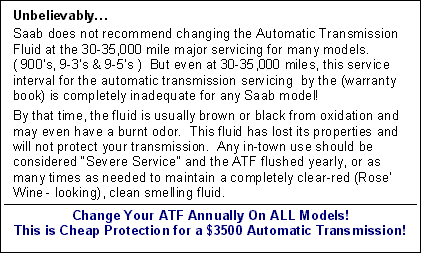
![]()
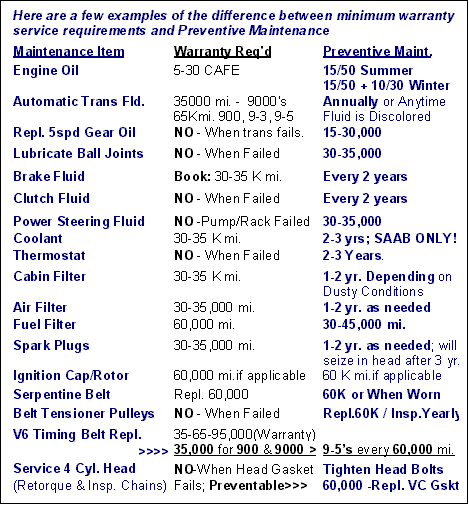
![]()
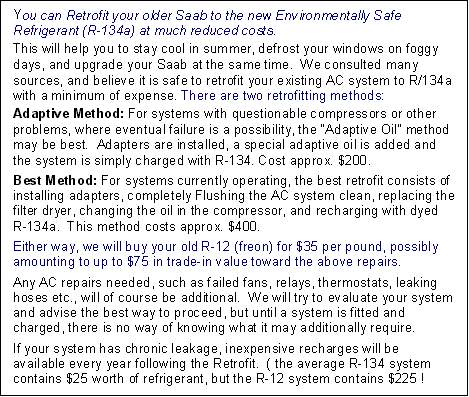

![]()
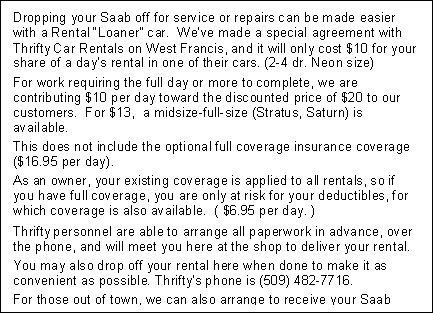

Remember to Keep Your Seat Belt Tight – You should always feel the tension of your belt on your chest.
Thanks for Reading! John & Brad